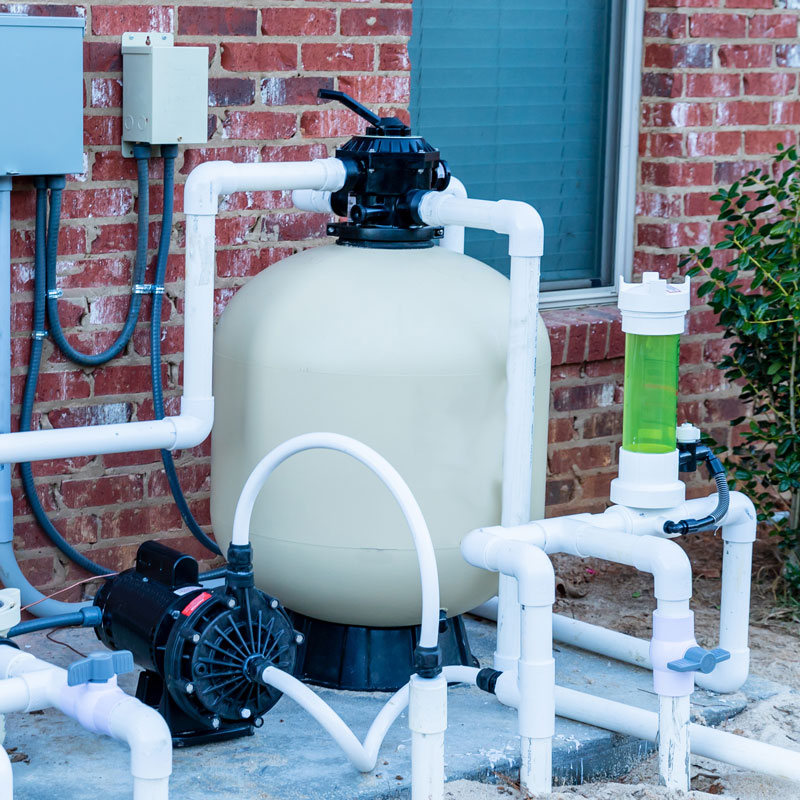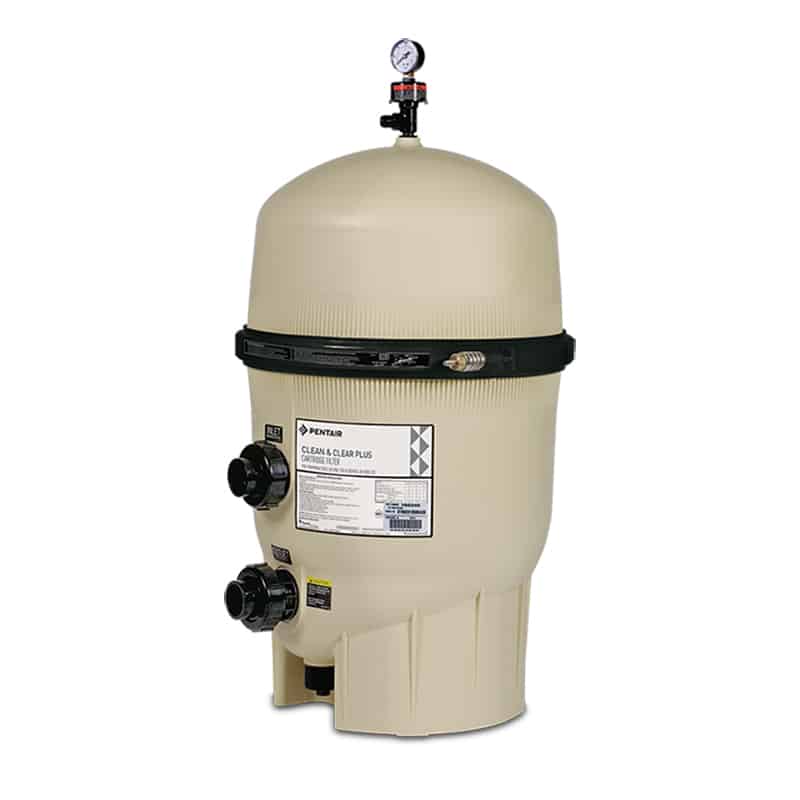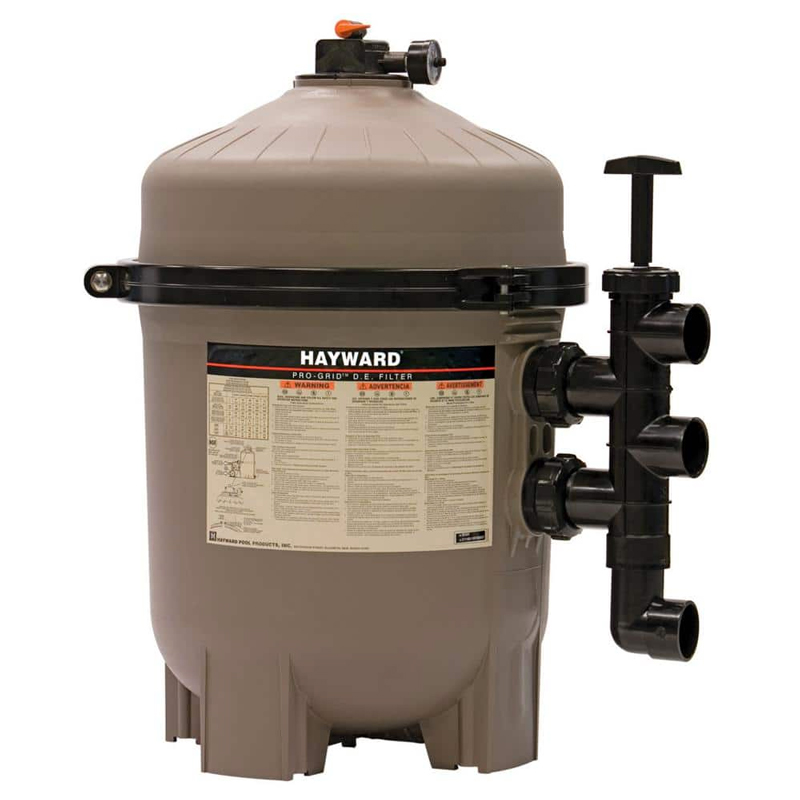
What’s the Difference Between Sand Filters, Cartridge Filters and DE Filters?
We all know that a crystal clear pool is the super star of the show. But somewhere, off to the side or behind the curtain, is the janitor who stays after the show to clean up and make sure that the theater (your pool) is ready for the next performance–your janitor is the Pool Filter. Pool filters are a critical component of your swimming pool–as they are the first and most valuable step to maintaining clear and healthy pool water. These are gunk-fighting devices that operate 24/7 to remove dirt, leaves and other debris, while your pool chemicals, like bromine and chlorine, work to destroy aquatic bacteria that lurks beneath!
The result? 5 star reviews from your friends and family–and most importantly, clean and clear water that looks as good as it feels on your skin!
However, not all janitors do the same work–just as not all filters are built to clean your pool the same way. In this post, we will compare the three most common types of pool filter systems: Sand Filters, Cartridge Filters, and DE Filters. Take a peak below if you want to know the specifics about each and what you should expect as you start to research swimming pools and pool filters for your backyard oasis!
Sand Filters vs. Cartridge Filters vs. DE Filters
Sand Filters
Sand filters are just that–they are filters that are full of sand! A sand filter tank is filled with #20 silica sand, and when water enters the tank, it is pushed down through the sand. That sand then traps dirt and debris while pumping the now-clean water back into the pool. They are the most traditional and cost effective option for your filter needs! Throughout the years, they have remained highly popular because of the efficiency, low maintenance costs, and natural approach/method to filtering out all of the unwanted particles and bacteria from your pool!
Speaking of particles and bacteria, these sand filters can capture up to anything larger than 20 Microns! Well, “How large is a Micron?” you might ask. For reference, a single strand of human hair is about 50 Microns. So in order for something to pass through the “firewall” that is your sand filter, it would have to be microscopic! Additionally, if you were to take a look at the sand filter media (the sand that is inside your filter) under a microscope, each piece is jagged and rough edged–which is why this filter is able to capture so much of the contaminants in your pool’s water!
However, the primary issue with Sand Filters is that they don’t catch everything. Bacteria usually range between 2-15 microns. So, while this filter will catch most of the contaminants in your water, it can miss some of the finer particles that pass through.
The reason for this is that over time, the sand particles in your sand filter media will erode and cause the filtration process to become less effective. It also leads to higher costs on chemicals and water due to how the system wastes water when backwashing. However, this only occurs after 5-7 years–in which time you will change the sand inside the filter.
Pros
- Cost of sand media is very inexpensive
- Uses less power to run (save $ on electricity)
- Optimal for Large Pools
Cons
- Sand media wears over time/replace every 5-7 years
- Have the smallest filtration area of the filters
- Misses bacteria smaller than 10 Microns
Cartridge Filters
The Cartridge filter, while simplistic in design, has a process filtering process that requires a bit more intricacy than the Sand filter. Each of the filters contain pleated polyester cartridges that are coated in a robust filter media! When the water enters the tank, it is then passed through the pleats in the filter–cleansing the water of any bacteria as small as 10 Microns! Thus, making it the more effective filter compared to the previously mentioned Sand Filter. In addition to the micron management features, The Cartridge Filter has the largest filter radius of the 3 listed in this post–filtering between 200-600 Sq. feet!
Additionally, these filters have a few recommendations attached to keep them operating at an optimal capacity. One such recommendation is that you pair it with a variable speed pump. The reason, Cartridge filters operate at their best when the pump that fuels them is running at a low and steady speed–which the variable speed pump offers! Secondly, we recommend that with whatever Cartridge Filter you choose, that it has the ability to utilize 2 to 4 filters. The reason for this is that your filter will be able to operate at a much higher capacity than if you had a single filter system–and you will only have to clean your multifilter system about once or twice per season!
Pros
- Filters Bacteria/particles as small as 10 Microns
- Largest Filtration area (200-600 sq. ft.)
- Perform well at low speeds
Cons
- Not optimal for Large Pools
- Higher Operating/maintenance cost
- Requires more hands on maintenance more often
DE Filters
DE filters, or diatomaceous earth filters, are the filters that have come from the front lines, to your pool side! These filters have been around since late WWII–where they were used to filter potable water for the soldiers at the time. Talk about built tough! For 70 years, the D.E. filter has been the most effective of all pool filters–capturing and removing particulates as tiny as 1-3 microns in size!
Unlike the sand or cartridge filters, the D.E. filters are so effective that pool owners won’t have to worry about any looming electricity bill increases due to long operating times, or extra expenses in purchasing additional sanitary products for their aquatic paradise!
D.E. filters are truly the superior option here in terms of delivering a pool that leaves you fresh and invigorated once you exit those waters. But like most things in life, the best is going to come with a slightly higher price tag and more maintenance.
The DE filters need to have replacement DE powder regularly added and must be completely taken apart every 6 months for a thorough cleaning to get all those tiny caught particulates out. Replacement filters can also get expensive, but they have a life expectancy of upwards of 15 years– so it isn’t an expense you’ll have to do often.
To summarize, the D.E. filter is the best of the best. But with high cost and high maintenance input, these filters are ones that will be better utilized by those who are really looking to up their pool’s hygienics and overall feel.
Pros
- Most effective cleaner/filter on the market
- Filters down to 1-3 Microns
- Performs well for all pools
Cons
- Higher Cost and Upkeep



